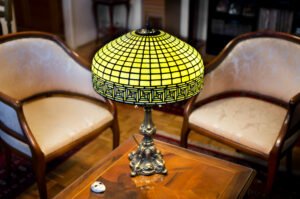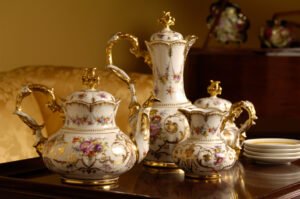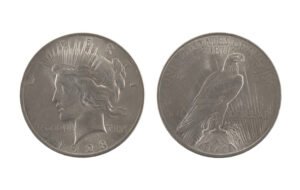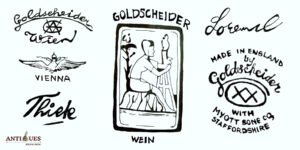Having a gumball machine at home was everyone’s dream in those old times. Affordable and fun, these machines attracted everyone from kids to adults. But what if I say that these antique colorful machines are still a point of attraction?
Well, that’s true! In fact, the gumball machine you’d have bought for one or two dollars back then can fetch you returns of $500 today! All you need to do is note its age, shape, and brand. Then, I’ll tell you how much to charge for those features of your vintage gumball machine!
Key Takeaways
- You can spot vintage gumball machines by their claw feet, coin slots, globes, and aging signs.
- Exclusive gumball machines with round or barrel globes and wood or metal sides fetch the best returns.
- You can trace the age and brand of your gumball machine by its dates, patent numbers, and logos. And you can find one on its base or metal case.
- Vintage gumball machines come in four types – Glass globe, Countertop, Carousel, and Wall-hanger. Of these, the glass globe and Carousel ones cost the most.
How to Identify An Authentic Vintage Gumball Machine

Well, I have to admit that there are too many forged gumball machines in the market. So, to spot an authentic one, check the machine’s base material. If it’s at least 3-5mm thick, it’s an old cast iron gumball machine. But if it’s thin and bendable, it’s probably new.
But if you are not 100% sure of the base material, here are other features to check out:
- Ornamental feet with metal claw designs and pointed edges
- Simple coin machines for pennies, nickels, and dimes
- Various glass stickers and paper labels for the flavor, price, and brand
- Round, square, globe-like, or fluted bases
- Teardrop, barrel, or square glass globes for more candy capacity
- Aging signs – Chipped paint, loose mechanical parts, and rusty bases, levers, or globes
Brief History of Vintage Gumball Machines
Vintage gumball machines, as we know them today, were not there until the 1880s. In fact, Thomas Adams (the same person who made chewing gums) made a gumball globe just to hold and display his pieces. It was simply made of metal and glass globes.
Things took a fancy turn in the 1930s as the1920s and 1930s were all about Art Deco and Nouveau styles. So, even the gum machines had glass, porcelain, and iron motifs. And thanks to the Ford company, they even got coin slots for easy vending.
But then followed the economic depression, and makers had to move to cheap plastic globes. They even reduced the machine size and made 8-9” countertop models.
Then, in the 1960s, the digital era popped up. And so, gumball machines had some crazy features like pinball, prizes, and fortune telling. But, these models were more of plastic and machine finishes. So, they became common and cost about $20 – 70, as per the game.
Finding the Value of Vintage Gumball Machines (8 Main Factors)
Common and easy-to-find vintage gumball machines are worth around $20 to $100, while the older and rarer machines can fetch high values of up to $10,000 or even more! Naturally, the final value of an old bubblegum machine changes with various other factors such as age, shape, and material.
1. Gumball Machine’s Date & Age
The older the antique, the more it’s worth. So, the first step to valuing a gumball machine is to find out its age via its manufacturing year! One way of doing so is to look for stamped dates or years on the base or top. But yes, that’s only for the branded pieces.
If your old gumball machine is unbranded, you can look for the patent numbers on the side or the back. Here’s a list for help:
| Year | Age | Patent Number | Estimated Value |
| 1994 | 29 years | US5452822A (Patent for Cylindrical Gumball Machines) | $70 – 350 |
| 1948 | 75 years | US2537317A (Patent for Countertop Gumball Machines) | $12 – 300 |
| 1950s | 73 years | D152883 (Patent for glass, 1-cent Gumball Machines) | $9 – 50 |
But, these patent numbers were simply stamped with ink. So, it’s possible that the old, rusty models don’t have any numbers. In that case, use the following clues:
The 1900s Gumball Machines
The 1900s were about solid cast-iron work. So, you’ll see the metalwork features – claw feet, decals, welded stands, and levers in gumball machines. Besides, you might see wooden bases, chutes, and porcelain motifs. So, they are costly, about $160 – 900 for one.
The 1930s Gumball Machines
If you love sleek and whimsical gumball machines, you’ll just fall in love with the 1930s models. That’s because these have curved and fancy Art Deco designs, chrome accents, glittery stickers, and stamps. Plus, you might also find some games and manual levers.
One more thing is that they might have polished wood or lacquer finishes instead of metal. So, depending on their condition, you can charge $20 – 200 for them.
The 1940s Gumball Machines
Does your gumball machine have Bakelite or plastic globes with an aluminum base? Or does it have thin, porcelain bands and trinkets? If yes, you might be looking at a 1940s gumball machine worth $20 – 150. Also, look for side coin slots and levers with this one!
Get gumball machines with metal cases and an inbuilt gumball bank system for an old and authentic make.
2. Shapes

Another quick visual test is to determine the gumball machine’s globe shape. Where the old gumball machines looked cylindrical, the new ones look domical. So, look for the custom-made barrel, teardrop, or round shapes for the best returns.
And if you want some help with pricing, check the table below:
| Old Gumball Machine Globe Shapes | Top Features | Average Cost |
| Teardrop or Cylindrical | Straight sides, narrow walls, and a tapering base, Found in companies like Columbus A, Victor Topper, and Oak Acorn series | $70 – 400 |
| Barrel Shaped Globe | Barrel-like glass shape and rounded edges, as in Thomas Adam’s models | $23 – 350 |
| Square Globe | Four flat sides, flat tops, and a cuboidal structure | $20 – 300 |
| Round or Dome | Spherical and curved walls such as those in Ford Penny gumball machines | $9 – 270 |
Look for gumball machines with novelty stands, geometric or abstract bases, and pedestal feet for the best returns.
3. Types of Vintage Gumball Machines
The value of a vintage gumball machine also depends on its type. For example, the glass glode gumball machines are worth more than the wall hanger machines. Below are the common types of old bubble gum vending machines and their average values!
Glass Globe Gumball Machine (1900s)

Glass globe machines are just like those large chocolate machines you see today. So, you’ll see some common features like round tanks, trinkets, and chutes. But what’s different is their metal or wood bases, claw feet, and puppet animations.
Other than that, you’ll also see a 12 – 16 mm slot and push-pull levers. Plus, there might be some glitter stickers, caps, or labels too. And depending on that, they cost about $18 – 350.
Countertop Gumball Machines (1930s)

Vintage countertop gumball machines are the smallest and decorated of them all. So, you’ll also see ornate cut glass and porcelain filigree work on all sides. Plus, you can easily fit them onto regular countertops.
But these machines have brittle glass or plastic walls and may not cost more than $300.
Carousel Gumball Machines (1950s)
If your old gumball machine has 5 – 6 sections for different candies, it might be a carousel gumball machine worth $50 – 135. Such machines are quite large and often have a central rod and lever to rotate the glass globe. Plus, they’ll be bold, painted, or galvanized.
Wall-hanger Gumball Machines (1950s)
Imagine a gumball machine in a picture frame! That’s how wall-hanger gumball machines look! Here, you’ll have a flat candy bank with a coin mechanism at the side. Also, you’ll see some hooks and round levers at the base. But these are small and cheap, at $20 – 60.
4. Stand and Machine Materials
The earliest gumball machines were all wood and metal, just like other antiques. But things took a sharp turn in the World War era. Since there was no money, makers shifted to brittle metals like plastic and acrylic. So, those are obviously cheaper than the antique models.
Want to know how an old gumball machine’s value changes with the materials? Here’s a list:
| Old Gumball Machine Materials | Average Cost for Unbranded Pieces | Average Cost for Branded Pieces |
| Wood – White Oak, Mahogany, or Pine | $35 – 140 | $65 – 250 |
| Metal – Cast or Alloyed Iron | $50 – 260 | $75 – 450 |
| Glass – Soda lime or Tinted | $19 – 225 | $30 – 350 |
| Steel or Aluminum | $20 – 100 | $40 – 240 |
| Plastic or Acrylic | $8 – 60 | $13 – 150 |
Avoid getting gumball machines with red oak walls, fasteners, screws, or metal castings, as those might be new and forged.
5. Brands

Don’t want to analyze the shape and material of your gumball machine? Try this shortcut! Simply check the machine’s brand, logo, and sign from its bottom plate and compare it with our table for the cost:
| Old Gumball Machine Brands | Manufacturing Year | Average Valuation |
| Ford Gum & Machine Company | 1913 | $90 – 300 |
| Columbus Vending Company | 1898 | $140 – 700 |
| Northwestern Corporation | 1909 | $50 – 370 |
| Coca – Cola | 1950s | $30 – 100 |
| Jelly Belly | 1960s | $20 – 60 |
| Beaver | 1960s | $30 – 160 |
Avoid getting chipped, scratched, broken, or faded gumball machines, as those might lose their value by 5 – 12%.
6. Rarity of Gumball Machines
It’s rare to see small antiques, like gumball machines, sell for more than $15,000 at any auction. But yes, some models with exotic wood walls, animations, or royal origins do sell for such high costs! So, check its finish and history before purchasing.
Here are some precious gum machines you can look for:
| Rare Gumball Machines | Estimated Value |
| Blinking Eye (Soda Mint Gum-machine from the 1930s) | $15,000 – 25,000 |
| Yellow Kid Dispenser by Pulver Company | $7000 – 10,000 |
| Pulvers One Cent Gumball Dispenser | $5000 – 10,000 |
7. Colors & Finishes
You’ll get antique gumball machines in three colors – bare metal, oxidized, and painted. Of these, the bare metal ones cost more due to their original finishes. Even the newer, red or blue ones are precious because of their hand touch.
But the oxidized ones – black and white, cost less than the two since they don’t last long. In fact, you can get them for as little as $20 – 60.
Vintage gumball machines won’t ever be painted from the inside. So if your device has red or blue ‘internal’ walls, it might be new and forged.
8. Metal Casing
If you want an authentic gumball machine, look for holes and mold marks on its metal case. Even the edges won’t be proper, and you might see uneven heights and curves. Other than that, these may have simple glued or pinned sides without extra screws and rivets.
How Old Are the Gumballs in Vintage Gumball Machines?
Most of the gumballs in any vintage gumball machine would be about 60 – 100 years old. But you can also see if you get a stamped gumball refill date to track the exact age.
How Many Gumballs Were There in a Vintage Gumball Machine?
Old gumball machines usually had about 400 – 520 gumballs. But, the small or countertop ones could hold only up to 300.
How Do You Clean a Vintage Gumball Machine?
You can clean vintage gumball machines with normal soap, vinegar, and water. Also, spray some linseed oil and scrape it lightly to remove all the sticky gum residue.
Vintage gumball machines are a favorite among young and old alike! But just ensure you don’t get scammed by the new replica models. As we saw, the vintage ones have solid wood or metal sides and a 1-cent coin slot. Also, they will surely have stamped dates and logos!
Note: This article is intended for informational, educational, and entertainment purposes only. Some images are illustrative and may not represent actual brands, products, or related entities. All trademarks, product names, brand logos, packaging, and other intellectual property referenced remain the exclusive property of their respective owners. Any brand mentions or references are provided solely for descriptive and educational context and do not imply any formal or commercial association.










